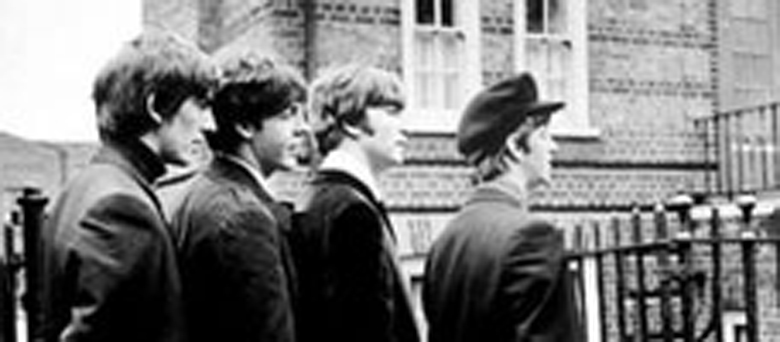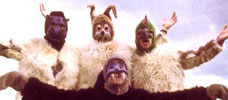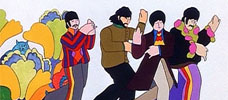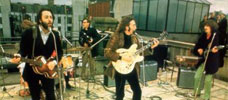Reviews
Richard Lester
UK, 1964
Credits
Review by Megan Weireter
Posted on 05 September 2009
Source Miramax DVD
Categories The Beatles on Film
The Beatles’ first and most celebrated film is also the film to which all the others are in some way forced to respond. It was the world’s first up-close-and-personal look at the band, for the film’s resemblance to reality, however tenuous, allows viewers to feel like they have actual relationships with the Beatles. If you’re a fan, A Hard Day’s Night is where you go to hang out with your idols as if they’re your friends, which you can do thanks to the film’s very realistic and very personal approach. And it’s a testament to the movie’s success, perhaps, that viewers have tended to take away so much that they feel to be true. Beatles mythology was born in A Hard Day’s Night—from here on out it can only be expanded, elaborated upon, or exploded.
And yet A Hard Day’s Night only exists because someone at United Artists was savvy enough to sense, in the fall of 1963, that publishing rights to Beatles music might turn out to be a lucrative thing to have. Once rights to a soundtrack album were negotiated, studio management hired a crew, gave them a pittance of a budget, and sent them out to film some movie, any movie, about the Beatles in March of 1964 for release that July. And why not? Pop music films up to that time had been slipshod because they could be, catering as they did to unsophisticated teenage girls who would happily buy their tickets to watch the likes of Cliff Richard jump adorably around for a while.1
There was no reason for anyone to try to make A Hard Day’s Night any different, other than the integrity of the Beatles themselves and the likemindedness of director Richard Lester and screenwriter Alun Owen. As with so much of Beatles history, a sense of kismet hangs around A Hard Day’s Night. Although the project was undertaken with the standard pop-movie small budget, rushed schedule, and low expectations, it turned out to be so much more than anyone expected thanks to the serendipitous meeting of a few like minds.
When the film was released, it was obviously a big hit with its intended audience, but critics surprised themselves by enjoying it almost as much as the fans. The film began to convince the older generation of the Beatles’ talent and staying power in a way that nothing that came before had—the Beatles were more than pop musicians, they were almost artists. (Their status as artists would be solidified with the release of “Yesterday” the following year, but A Hard Day’s Night got them much of the way there.) But while all this is true, so much has been made of the film’s unique appeal beyond the teenage demographic that I think it’s easy to miss how terrifically it happens to do its job of relating to teenagers. It’s not just that it’s a movie about teen idols—it’s a movie about youth’s dissatisfactions and injustices, about the restlessness and itching for freedom that’s so central to being human and so particularly powerful when you’re young. A Hard Day’s Night is as beloved as it is not just because it stars the Beatles, but because it shows us that the Beatles share our restlessness. They are, as Us Magazine would say, just like us. To a teenager infatuated with these untouchable musicians who seem a world away, that connection means everything.
The film’s sense of connection comes from its premise as a typical day in the life of the Beatles. This way the fans get to experience their idols in their real lives, as authentically as possible in a scripted film—which makes it a shrewd decision not only for artistic and budgetary purposes, but also for marketing, as of course intimacy with the Beatles is exactly what the target market craved. These particular couple days, as with every day of their lives, are scheduled to the minute, with time allotted for rehearsals, answering fan mail, speaking to reporters at press conferences, and waiting quietly where they’re told to until they’re needed. Much of the rest of their time is spent outrunning crazed teenage fans, enacting elaborate schemes to distract the crazed teenage fans with decoy cars and the like, and finally performing to an audience full of crazed teenage fans who scream, weep, and spasm in the aisles.2 The only element that seems a bit out of the ordinary on these couple days is that Paul’s grandfather, played by British TV actor Wilfrid Brambell, has come along on the trip, much to the annoyance of the entire entourage—though what is striking is just how well he ends up fitting with the band.
The film’s commitment to realism ends up deconstructing the glamour of the Beatles’ fame. As Paul’s grandfather notes with disgust, all their rock-and-roll lifestyle boils down to “a train and a room and a car and a room and a room and a room.” Their imprisonment by fame imposes a false childhood upon them, in which they can’t safely socialize with others their own age or even see people other than the people who work for them. Norm is not only a manager, he’s a domineering paternal figure who keeps the boys reined in. Early on, the boys sneak out to a dance club just for a change of scenery, and when Norm shows up to chastise them and bring them back to the hotel, it’s as humiliating as your parents coming to do the same thing when you’ve stayed out past curfew. “If you don’t need them, I’ll lock them up in the dressing room,” he says at one point to the TV director. When the Beatles aren’t being treated like children, they’re being treated like a commodity—it’s no wonder they’ll try to break out any chance they can.
The oppressive atmosphere makes their every snide remark and witticism an act of rebellion. Compare A Hard Day’s Night’s most decadent scene (in which the Beatles literally break out of the TV studio, run down a fire escape, and jump around being silly in a field) to the apocryphal stories about other rock stars’ decadence that you’ve heard or seen in other films. On paper, the Beatles’ escape seems as tame as can be. In context, it’s a moment that absolutely makes your spine tingle. This is smart—the rebellious spirit that drives this scene appeals to teenagers, of course, but it’s expressed in such a relatable way that rebellion seems fun to anyone else watching as well. It’s as if a rock and roll paradigm has been finally and clearly linked to the universal thirst for freedom that always lay behind it, thus bringing rock closer to mainstream acceptability. (This kind of relatability and even silliness is part of how the Beatles were able to pull one over on all the fans’ parents and convince them of their own harmlessness—at least compared to the Stones and the Who and whatever other band was setting things on fire in the newspaper that week. Whereas the fans always knew better, I think, than to assume that the Beatles would ever be interested in just holding your hand.)
What also helps make the urge to escape all the more universal is that, with the exception of the jumping-in-the-field scene, the real world that the Beatles sometimes manage to escape into is so awful and boring. There’s George, who accidentally wanders off and gets scooped by a marketing professional of some sort—one whose finger is so on the pulse of teenage culture that he doesn’t recognize a Beatle when he sees one. One of the most celebrated scenes in the film, for George Harrison’s naturalism as much as anything else, it’s also one of the most overtly satirical. And it’s completely hilarious for the way George roundly, and innocently, denounces the profession of marketing products to teenagers. (He’s written off as merely a troublemaker, though.)
And of course Ringo, who’s convinced to escape by the real troublemaker, Paul’s grandfather, has nothing but bad luck out on the town. (Paul’s grandfather seems to have spent his entire life breaking the rules of polite society, but it’s only made him bitter and ornery, such that he tries to channel his fantasies through Ringo.) Ringo’s every impulse is misunderstood, and his ineptitude and awkwardness eventually get him held by the police. Though it’s all played for comedy, that awkwardness in the world would have been easily understood by teenagers, and once again brings the Beatles into the realm of the relatable. The little boy Ringo befriends briefly seems like his natural soulmate of sorts (they settle into easy banter in no time) and indeed the boy might be the only truly free character in the whole movie. Deserting school is simple, deserting one’s adult responsibilities not so much. Ringo watches with real wistfulness as the boy runs back to hang out with his friends, in a scene that brings us as close to something overtly serious as the film ever really gets. Since this is a Beatles movie, of course the music is paramount. Audiences for A Hard Day’s Night were treated to a collection of brand new songs that are the band’s crowning achievement up to that point in their career.3 Remarkably for the time, each song is an original Lennon-McCartney composition. (The A Hard Day’s Night album released on Parlophone in Britain is the only Beatles album made up of only Lennon-McCartney songs. UA got their coveted rights to the soundtrack in the U.S., where the album was released with a B-side of instrumentals from the film.) As they wrote the songs, John and Paul had no guidelines—there was no script yet for them to attempt to shoehorn songs into, so they’re just Beatles songs, written naturally as possible.
Lester must have understood how special this music was, for he films performances in a way that makes perfect sense and heightens their effect while seamlessly meshing with the film. Of course, the scene in the field set to “Can’t Buy Me Love,” a song so upbeat as to be almost manic, is one of the most famous and the most exhilarating—this is the kind of scene that people have in mind when they say that Lester helped invent the music video. But all the musical scenes are wonderful. For the uptempo harmonica-driven bluesiness of “I Should Have Known Better,” the Beatles sit in the back of a train in the pet stowage section, playing cards that turn magically into guitars as the song gets underway, stared at by the dogs and, eventually, the inevitable teenagers peering at them through the grate. It’s easy to read the Beatles literally behind bars as a pretty weighty statement of what the film is about, but the dogs and the gawking teenagers make the picture pleasantly surreal. For “And I Love Her,” the crew worked for hours to perfect a circular shot of Paul McCartney singing in silhouette against a stage light—a shot that studio executives initially took to be a mistake. The light framing Paul’s face makes the stagecraft behind the Beatles visible even as it introduces an element of the sublime—it’s one of the single most perfect shots of the film. And I’ve always loved the “If I Fell” scene, in which Ringo finishes setting up his drum kit just in time for his entrance after the eight introductory bars. In this scene, the Beatles see their instruments waiting for them on stage and literally run down to start playing. They can’t stop themselves. This is their only true escape—the only area of their lives in which no one is telling them what to do.
The Beatles might be imprisoned by fame, but the watered-down depiction of their imprisonment is accessible to any teenager who feels like they’ll never break free of the repressive regimen adults have opposed upon them. And while the Beatles find freedom playing this music, their fans experience a kind of freedom listening to it. Rock & roll has always been thus, which is why its appeal has always been to the young, the disaffected—those who feel trapped by circumstances they can’t control, namely their age. Paul’s grandfather might protest otherwise, but he’s one of the original rock and rollers, in his way, which is why he’s so much fun to have around in this movie.
A Hard Day’s Night is, on the surface, a particularly well-done musical comedy, but it’s also about youth and all of its dissatisfactions and injustices in a more general way. It remains as beloved as it is not only because it involves the Beatles, but because its taste for liberty—and for mischief—is so universally understood. The film doesn’t feel particularly dated, because youth culture hasn’t changed in any of its essentials. No matter your age, it’s still fun to watch A Hard Day’s Night to see all the old squares taken down, to experience the thrill of excellent rock music, and to see how the Beatles embodied the escape fantasies of their generation.
- I count myself as one of these fans who would watch pretty much anything involving the Beatles, if I’m honest. So _A Hard Day’s Night_ could have been 90 minutes of the Beatles quietly doing crosswords or playing bingo (“Pas bingo, monsieur, Bocco”) and I’d still be writing this, trying to convince you that the film’s merit derives from the power of Paul McCartney’s big gooey eyes. Luckily, it’s a good movie.
- The film’s crew was completely taken aback by the madness that the Beatles were living with every day. At the end of the first day of filming, a young crew member who happened to have a slightly Beatles-esque haircut was carrying a tall stack of film canisters off a train when a huge mob of girls started running at him. He panicked, dropped the film, and ran off like his life depended on it; almost the whole day’s worth of filming was ruined. And at least one poor cameraman who filmed in the middle of the concert audience had all his teeth actually knocked loose by the acoustic of unceasing teenage screams.
- We’re so overexposed to Beatles music now that it can be harder to hear how exhilarating their early work is. But imagine hearing that mind-blowing opening chord of “A Hard Day’s Night” for the first time, in the theatre, as the Beatles themselves run out of the screen toward you! Some people wish they’d seen _Psycho_ or _The Empire Strikes Back_ on opening day, but _A Hard Day’s Night_ is my top pick for a wish-I’d-been-there opening.
More The Beatles on Film
We don’t do comments anymore, but you may contact us here or find us on Twitter or Facebook.








